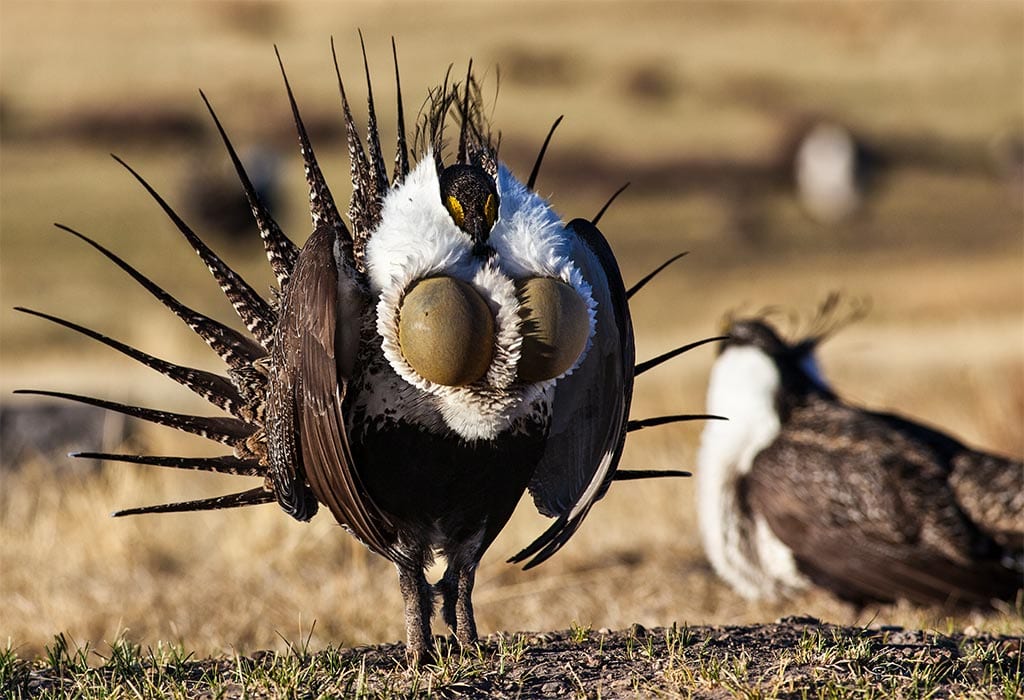Current work in wildlife, rivers, public lands, and climate
Press Releases
Federal judge overturns Trump administration’s gutting of greater sage grouse protections
U.S. District Judge Lynn Winmill said the Bureau of Land Management failed to provide a “reasoned explanation” for canceling its own earlier proposal to protect the highest-priority sagebrush habitats from hard-rock mining. His decision follows an earlier ruling stemming from a 2016 lawsuit filed by conservation groups, finding that Trump administration changes to federal land management plans failed to protect the iconic western bird from fossil fuel development, grazing and mining.
“We’re grateful our legal system once again protected the vanishing greater sage grouse from the reckless, lawbreaking Trump administration,” said Michael Saul, a senior attorney at the Center for Biological Diversity. “This illegal gift to the mining industry lifted protections for 10 million acres of the most important sage-grouse habitat and would’ve pushed this beautiful bird closer to extinction. Now the new Interior secretary can establish appropriate habitat protections based on science, not favoritism to the mining industry.”
In today’s ruling, the judge recognized a 2011 BLM analysis as the best available science on sage-grouse conservation measures, an analysis the Trump administration ignored. The judge also noted that the U.S. Fish and Wildlife Service relied on designating sage grouse priority habitat areas and conservation projections in its 2015 decision to deny protections for greater sage-grouse under the Endangered Species Act.
“Greater sage grouse are one of many species across the American West whose very existence is in jeopardy, which made the Trump administration’s decision to put the interests of industry over the protection of this iconic species even more reckless,” said Lindsay Larris, wildlife program director at WildEarth Guardians. “We are hopeful that the new Biden-Harris administration will take the biodiversity crisis seriously and see this decision as a step toward getting greater sage grouse the protection they need in order to thrive.”
The grouse is under threat because it is intensely loyal to particular areas, reliant on large expanses of intact sagebrush, and especially sensitive to disturbance and habitat fragmentation. It also needs enough vegetation cover and nutrition to raise chicks, unaltered mating grounds called “leks” for reproduction, and sufficiently healthy winter habitat to survive the cold season.
“This ruling is a decisive win for sage grouse and all the other species of wildlife that rely on healthy sagebrush habitats,” said Erik Molvar, a wildlife biologist and executive director with Western Watersheds Project. “Because this particular court has adjudicated so many sage grouse lawsuits, the judge has a command of sage-grouse science and was able to expose the Trump administration’s dismantling of habitat protections as an arbitrary attack on common-sense habitat protections.”
Greater sage grouse once occupied hundreds of millions of acres across the West, but their populations have plummeted as oil and gas extraction, livestock grazing, roads and power lines have destroyed and fragmented their native habitats. Protecting the grouse and its habitat benefits hundreds of other species that depend on the Sagebrush Sea ecosystem. That includes pronghorn, elk, mule deer, golden eagles, native trout, and migratory and resident birds. The Bureau of Land Management is responsible for managing about half of the nation’s remaining sage-grouse habitat.
“This decision is a stinging rebuke of the Trump administration’s total disregard for fact and science,” said Sarah Stellberg, an attorney with Advocates for the West, which is representing the plaintiffs. “It’s also a crucial win for sage grouse, who now more than ever need the protections this mining ban would provide.”
The court’s decision does not immediately reinstate the 2015 mining ban, but provides the Bureau of Land Management a second chance to evaluate appropriate protections for sagebrush focal areas in light of scientific evidence. This is the latest in a series of legal defeats for the Trump administration’s efforts to undermine conservation measures for sage grouse habitat on public lands.
Attorneys from Advocates for the West represent Western Watersheds Project, the Center for Biological Diversity, WildEarth Guardians and Prairie Hills Audubon Society in this case.

Greater sage grouse. Photo by Bureau of Land Management.